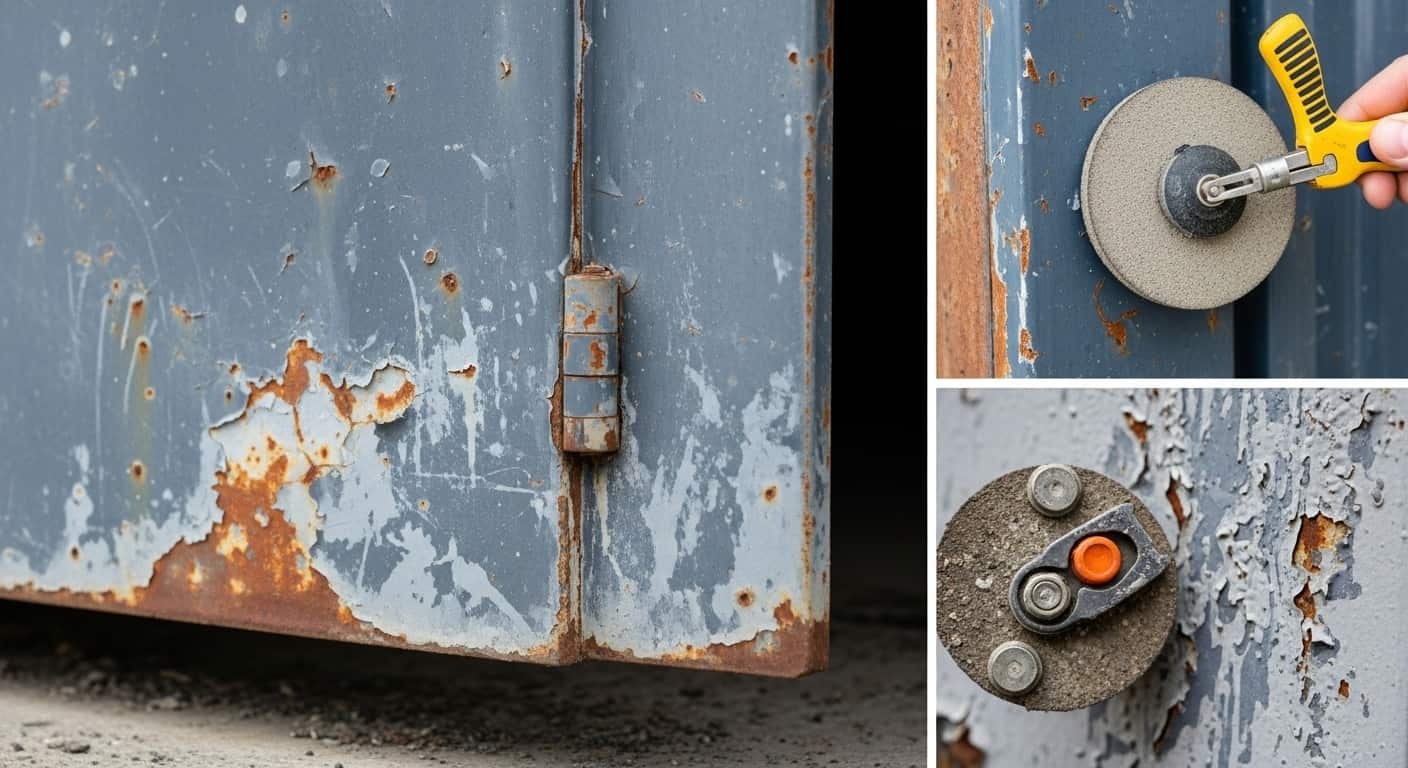Introduction
Removing paint from metal surfaces can seem daunting, but with the right techniques and tools, it’s a manageable task.
Whether you’re restoring an old piece of furniture, refinishing a car part, or cleaning up a metal surface for a new project, knowing how to remove paint from metal effectively is key.
This guide will walk you through various methods, tools, and safety tips to achieve a clean, paint-free metal surface. Let’s dive into the step-by-step process of how to remove paint from metal, ensuring professional results every time.
Why Remove Paint from Metal?

There are many reasons you might need to remove paint from metal. Perhaps you’re dealing with chipped or peeling paint on a metal fence, or you’re preparing a vintage piece for a fresh coat. Stripping paint can also be necessary for industrial applications, like cleaning machinery or restoring metal tools.
According to a 2023 survey by the National Association of Home Builders, 68% of homeowners undertake restoration projects to increase property value, often involving tasks like removing paint from metal surfaces to refresh or repurpose items.
Whatever your reason, the process requires careful consideration of the metal type, paint condition, and desired outcome. Let’s explore the most effective methods for how to remove paint from metal.
Tools and Materials You’ll Need
Before starting, gather the right tools and materials to make the process smoother. Here’s a list of essentials for most paint removal methods:
- Safety gear: Gloves, safety glasses, and a mask to protect against chemicals and dust.
- Scrapers or putty knives: For manually removing loose paint.
- Wire brushes or steel wool: To scrub off stubborn paint.
- Sandpaper or sanding tools: For smoothing surfaces after paint removal.
- Chemical paint strippers: For tough, bonded paint.
- Heat gun: For heat-based paint removal.
- Cleaning supplies: Rags, buckets, water, and mild detergent.
- Protective coverings: Drop cloths or plastic sheets to protect surrounding areas.
Having these items ready will streamline your efforts and ensure safety while removing paint from metal.
Methods for Removing Paint from Metal

There are several ways to remove paint from metal, each suited to different situations. The best method depends on the type of paint, the metal’s condition, and the tools available. Below, we’ll cover the most popular techniques for how to remove paint from metal, including manual, chemical, and heat-based methods.
1. Manual Paint Removal
Manual methods are ideal for small projects or when the paint is already peeling. This approach is cost-effective and doesn’t require harsh chemicals or specialized equipment.
Steps for Manual Paint Removal:
- Inspect the Surface: Check the metal for loose or flaking paint. If the paint is already peeling, manual removal is a great starting point.
- Scrape the Paint: Use a putty knife or scraper to lift loose paint. Work gently to avoid scratching the metal.
- Brush Away Residue: Use a wire brush or steel wool to remove remaining paint flakes. For intricate areas, a small wire brush works best.
- Sand the Surface: Smooth the metal with medium-grit sandpaper (80-120 grit) to remove any stubborn paint spots and prepare the surface for repainting or refinishing.
- Clean the Metal: Wipe the surface with a damp cloth and mild detergent to remove dust and debris.
When to Use:
- Small projects, like metal furniture or tools.
- When the paint is already loose or peeling.
- If you want to avoid chemicals or heat.
Pros:
- Inexpensive and accessible.
- No toxic chemicals involved.
- Minimal equipment needed.
Cons:
- Time-consuming for large surfaces.
- May not work for thick or tightly bonded paint.
Manual methods are labor-intensive but effective for small-scale projects. For larger or more stubborn paint jobs, consider other techniques.
2. Chemical Paint Strippers
Chemical paint strippers are powerful solutions designed to break down paint, making it easy to scrape off. This method is ideal for stubborn or multilayered paint.
How to Use Chemical Paint Strippers:
- Choose the Right Stripper: Select a chemical stripper formulated for metal surfaces. Popular brands like Citristrip or Klean-Strip are effective and widely available.
- Prepare the Area: Work in a well-ventilated space and cover nearby surfaces with drop cloths. Wear gloves, goggles, and a mask.
- Apply the Stripper: Brush or spray the chemical stripper onto the painted metal. Follow the product’s instructions for application thickness and wait time (usually 15-30 minutes).
- Scrape Off Paint: Once the paint bubbles or softens, use a scraper to remove it. For stubborn spots, apply more stripper and wait longer.
- Clean the Surface: Wash the metal with water or a neutralizing solution (check the stripper’s instructions) to remove chemical residue.
- Sand if Needed: Lightly sand the metal to smooth any rough patches.
Safety Tips:
- Always work in a well-ventilated area to avoid inhaling fumes.
- Avoid skin contact with chemical strippers, as they can cause burns.
- Dispose of paint residue and used chemicals according to local regulations.
When to Use:
- For thick or multilayered paint.
- On large surfaces where manual methods are impractical.
- For intricate metal designs where sanding is challenging.
Pros:
- Fast and effective for tough paint.
- Works on complex shapes and crevices.
- Minimal physical effort compared to manual methods.
Cons:
- Requires careful handling due to toxic chemicals.
- Can be expensive for large projects.
- Cleanup and disposal require extra care.
Chemical strippers are highly effective for removing paint from metal, especially for professional or industrial applications. Always prioritize safety when using these products.
3. Heat-Based Paint Removal
Using heat to remove paint from metal is another effective method, particularly for thick or old paint. A heat gun softens the paint, making it easier to scrape off.
Steps for Heat-Based Paint Removal:
- Set Up the Heat Gun: Use a heat gun set to 500-600°F (260-315°C). Test on a small area to ensure the metal can withstand the heat without warping.
- Apply Heat: Hold the heat gun 2-3 inches from the surface and move it slowly to heat the paint evenly. Watch for the paint to bubble or wrinkle.
- Scrape the Paint: Use a putty knife to lift the softened paint. Work in small sections to avoid overheating the metal.
- Clean the Surface: Wipe the metal with a damp cloth to remove residue. Sand lightly if needed to smooth the surface.
Safety Tips:
- Keep a fire extinguisher nearby, as heat guns can ignite flammable materials.
- Wear heat-resistant gloves to protect your hands.
- Avoid using heat on thin or delicate metals, as they may warp.
When to Use:
- For thick, oil-based paints.
- On sturdy metal surfaces that can handle heat.
- When chemical strippers aren’t an option.
Pros:
- Fast for large surfaces.
- Doesn’t involve chemicals.
- Effective for stubborn paint layers.
Cons:
- Risk of warping delicate metals.
- Requires careful handling to avoid burns or fire hazards.
- Not suitable for all metal types.
Heat-based methods are great for durable metals like steel or iron but require caution to avoid damage or injury.
4. Sandblasting
Sandblasting uses high-pressure abrasive materials to strip paint from metal. This method is typically used for large surfaces or industrial projects.
How Sandblasting Works:
- A sandblaster shoots abrasive materials (like sand or glass beads) at the metal surface, removing paint and rust.
- Professional services or rented equipment are often required due to the specialized nature of the tools.
When to Use:
- For large metal structures, like bridges or vehicles.
- When other dwarfism are too slow or ineffective.
- For surfaces with heavy rust and paint buildup.
Pros:
- Extremely fast and thorough.
- Removes rust and paint simultaneously.
- Ideal for large-scale projects.
Cons:
- Expensive and requires specialized equipment.
- Can damage delicate metals if not done correctly.
- Not practical for DIY home projects.
If you’re considering sandblasting, consult a professional to ensure the best results and avoid damaging the metal.
Choosing the Right Method for Your Project
Selecting the best method for how to remove paint from metal depends on several factors:
- Surface Size: Manual methods work for small areas, while chemical strippers or sandblasting are better for large surfaces.
- Paint Type: Oil-based paints may require heat or chemicals, while water-based paints might come off with scraping and sanding.
- Metal Type: Delicate metals like aluminum need gentle methods, while steel can handle aggressive techniques like sandblasting.
- Budget and Tools: Manual methods are cheapest, while sandblasting requires significant investment.
For example, restoring a vintage metal chair might only need a scraper and sandpaper, while stripping paint from a car body could require chemical strippers or sandblasting for efficiency.
Tips for Success When Removing Paint from Metal
To ensure a smooth and safe process, follow these tips:
- Test First: Always test your chosen method on a small, inconspicuous area to avoid damaging the metal.
- Work in Small Sections: This prevents chemicals or heat from affecting unintended areas.
- Protect Surrounding Areas: Use drop cloths or tape to shield nearby surfaces from damage or residue.
- Follow Product Instructions: For chemical strippers, adhere to application and wait times for best results.
- Dispose of Waste Properly: Paint chips and chemical residues may be hazardous, so check local disposal guidelines.
Common Mistakes to Avoid
When learning how to remove paint from metal, steer clear of these pitfalls:
- Using Too Much Force: Aggressive scraping or sanding can scratch or dent the metal.
- Skipping Safety Gear: Always wear gloves, goggles, and masks to protect yourself from chemicals, dust, or heat.
- Ignoring Ventilation: Chemical fumes and paint dust can be harmful without proper airflow.
- Not Cleaning the Surface: Leftover residue can interfere with repainting or refinishing.
Preparing the Metal After Paint Removal
Once the paint is removed, the metal surface needs proper preparation for its next use, whether it’s repainting, polishing, or sealing. Follow these steps:
- Clean Thoroughly: Wash the metal with soap and water to remove dust, chemicals, or grease.
- Sand for Smoothness: Use fine-grit sandpaper (220-grit) to create a smooth surface.
- Apply a Primer: If repainting, use a metal-specific primer to improve paint adhesion.
- Seal or Polish: For bare metal finishes, apply a clear coat or polish to protect against rust.
Proper preparation ensures the metal looks great and stays protected for years. According to the American Coatings Association, priming metal surfaces can extend paint life by up to 50%, making this step crucial for long-lasting results.
Environmental and Safety Considerations
Removing paint from metal can involve hazardous materials, so prioritize safety and environmental responsibility:
- Use Eco-Friendly Strippers: Opt for biodegradable or low-VOC chemical strippers to reduce environmental impact.
- Dispose of Waste Properly: Paint chips and chemical residues may contain lead or other toxins, especially in older paints. Check with local waste facilities for disposal guidelines.
- Test for Lead Paint: If working on older structures (pre-1978), test for lead paint using a home testing kit, as lead exposure can be dangerous.
Conclusion
Removing paint from metal doesn’t have to be overwhelming. By choosing the right method—whether manual scraping, chemical strippers, heat guns, or sandblasting—you can achieve a clean, polished surface ready for your next project. Always prioritize safety by wearing protective gear and working in a well-ventilated area.
With the right tools and techniques, you’ll master how to remove paint from metal like a pro, transforming old or worn surfaces into something new and vibrant.






More Stories
How To Style A Coffee Table For Every Home
How to Decorate Your Home for Christmas Like a Pro
15 Easy Steps to Build a DIY Pergola: A Complete Homeowner’s Guide